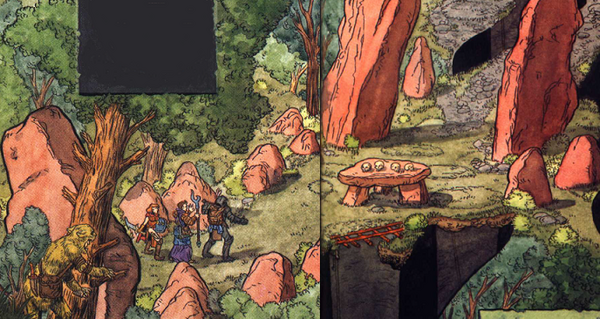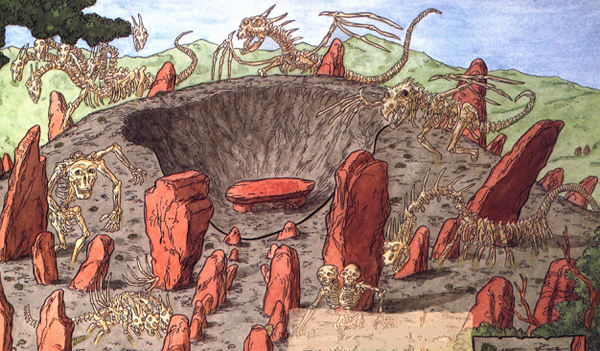The Bone Dance was a hill located in the Border Forest of north Faerûn. Around the Year of Wild Magic, 1372 DR, it was the site of ghostly apparitions of skeletal monsters that danced around the peak of the hill and attacked any intruders.[1] The Bone Dance was sacred to a tribe of Malar worshipers known as the Rauthtor.[2]
Geography[]
The Bone Dance rose out of the dense trees like a bald dome in the southern third of the Border Forest, north of Dagger Falls and the Desertsmouth Mountains. The hill was almost devoid of greenery and was studded with sharp boulders and megaliths that formed a spiked crown around the top and created obvious trails up the sides. The surface was mostly a scree of gravel and dirt that cascaded down the slopes but eventually gave way to underbrush toward the foot of the hill. At the apex was a roughly circular depression about forty to fifty feet (twelve to fifteen meters) across and twenty feet (six meters) deep.[1]
Features[]
Approaching the base of the Bone Dance on one side was a cleared path outlined by rows of large boulders, known as "the Throat".[2] It culminated in a wider area with a stone table or altar in its center, made of a flat slab atop three smaller boulders.[note 1] Another altar—much larger, more rectangular, sitting on two flat boulders, and darkened by years of repeated bloodstains—rested at the bottom of the bowl at the top of the hill.[1]

Adventurers approach the Bone Dance via "the Throat" under observation by a Malarite. A false altar surrounded by fangfalls (shown in cutaway view) displays some skulls of previous victims.
The Bone Dance[]
At various times, day or night, oversized phantom skeletons of a wide variety of monsters pranced, marched, or cavorted above, around, and through the spiky crown of megaliths that surrounded the pit with the large altar. At night, the figures were outlined in an eerie glow that made them visible from far away, but in daylight, observers had to get dangerously close to the hill to see them. Those that survived an up-close encounter with the dancing denizens reported seeing bony behirs, chimeras, dragons, giants, hydras, illithids, tanar'ri, trolls, and wyverns, all of impressive size and fearsome visage, their heads scanning the surrounding forest for prey, but missing their feet—the apparitions faded away at the ankles. Often, the monsters had extra heads or limbs. Occasionally, the skeletons became fleshed out, displaying a body, fur, or hide, only to fade back to a skeleton a short time later.[1][2]

Monstrous skeletons cavort around the hilltop. A cutaway view shows a stone altar in the center of a pit.
Normally deathly silent, sometimes the Bone Dance would emit a wolf howl, strange hoots, or a roar that shook the ground and could be heard for miles. The folks of northern Daggerdale named these bestial roars "longthunder". When an intruder was spotted, the Bone Dance erupted in spine-tingling snarls and growls as all the phantoms gave chase with the obvious intent to rend the interloper limb from limb.[2]
Defenses[]

Stakes and snakes await a victim at the bottom of a fangfall.
Most of the trails leading to or from the Bone Dance were protected by pit traps, known as "fangfalls" to the Malarites. These hazards were typically a sheer drop of twenty feet (six meters) onto a bed of sharpened wooden spikes prowled by poisonous snakes. Fangfalls were concealed by covers made of a lattice of thin branches just strong enough to support some camouflage in the form of dead leaves, live plants, moss, fungi, vines, and dirt. The Rauthtor encouraged shrubs and other underbrush to grow nearby for added concealment. The stakes were affixed to a sturdy frame that could be raised and lowered by ropes to facilitate repairs and removal of victims. These ropes were anchored under the lip of a trap and not visible until the cover was removed or broken through.[2]
The Snarling Hunt[]
The Malarites themselves were the most effective defense, hiding high in the surrounding trees and behind the larger boulders. They were responsible for the detailed and believable illusions that paraded around the hilltop, and for giving chase when intruders got too close to their sacred site. Being pursued by ghostly skeletons and guttural animal cries made their victims sweat with delicious fear, but it was the Rauthtor that did the killing, dressed in pelts, wearing realistic beast head-coverings, and using claws of Malar, beast claw spells, and clubs studded with real animal teeth and talons. When overtaken by blood lust, they would hound a victim relentlessly, wounding to draw blood but withholding the killing blow as long as the prey continued to flee.[2]
History[]
In the early 1260s DR, Manshoon was consolidating his power in Zhentil Keep with the help of Fzoul Chembryl. A group of Malarites fled the city and the influence of the church of Bane and founded a tribe of the People of the Black Blood[note 2] in the Tesh Valley. The tribe called themselves the Rauthtor, after a farmer who had gone feral and hunted down the orcs that slew his family. The Rauthtor were not welcomed by the folk of Teshendale, so they retreated into the Border Forest and eventually made the Bone Dance their sacred site.[2]
Of all the fanciful stories told about the doings around the Bone Dance, the most often told tale (with myriad embellishments) was the true story about the Brave Blade adventuring company. Around the Year of the Spur, 1348 DR, this young and enthusiastic group from Yhaunn were in Daggerdale and a furrier named Lhastal Darramooth hired them to put a stop to the haunting of the Bone Dance. They set out one morning in high spirits, but their bravado was not enough to keep them from harm. That very night, hopelessly outnumbered, they were hunted down, interrogated, and then gruesomely put to death. The next day, there was a trail of blood from the forest to Darramooth's door, where a few grisly body parts were left as a warning. The heads of the ill-fated adventurers were never recovered. The Rauthtor used their skulls to occasionally mark a trail by placing them on prominent rocks or in tree boughs as a warning to others.[2]
Rumors & Legends[]
Most theories about the purpose of the altar at the top of the Bone Dance were religious in nature. Speculations included one of the Beast Totem tribes, an actual beast cult, or worshipers of one of the gods of death or the dead. One particularly fanciful story involved a Bone Lord worshiped by undead monsters. The rumormongers that said it was a corrupted Malarite cult were not far from the truth.[1]
Appendix[]
Notes[]
- ↑ Description based on artist's rendering.
- ↑ It is unclear whether any of the members of the Rauthtor were lycanthropes since they attacked in human form wearing costumes of wild animals.
References[]
- ↑ 1.0 1.1 1.2 1.3 1.4 1.5 Ed Greenwood (May 2002). “Elminster's Guide to the Realms: The Bone Dance”. In Jesse Decker ed. Dragon #295 (Wizards of the Coast), p. 78.
- ↑ 2.0 2.1 2.2 2.3 2.4 2.5 2.6 2.7 Ed Greenwood (May 2002). “Elminster's Guide to the Realms: The Bone Dance”. In Jesse Decker ed. Dragon #295 (Wizards of the Coast), p. 79.
